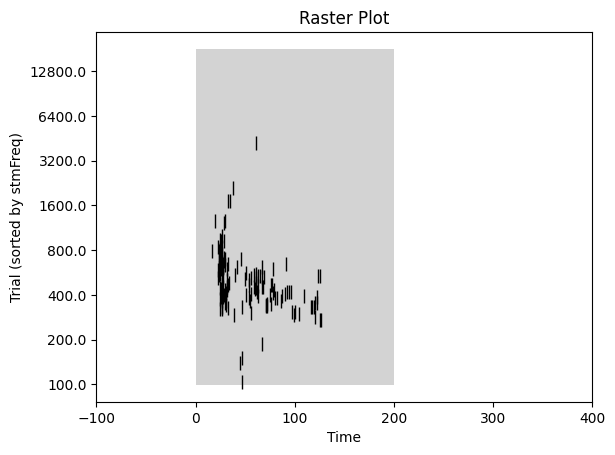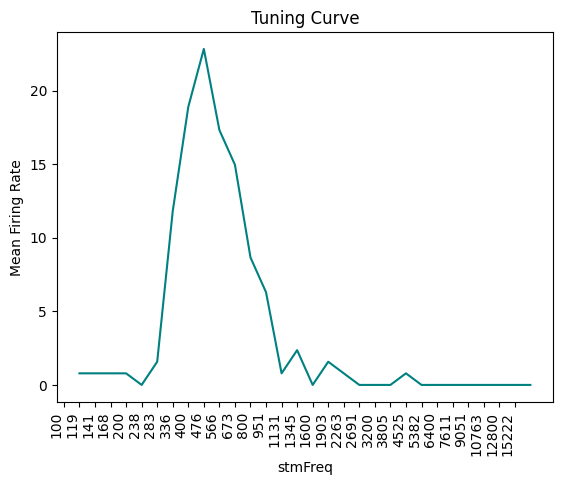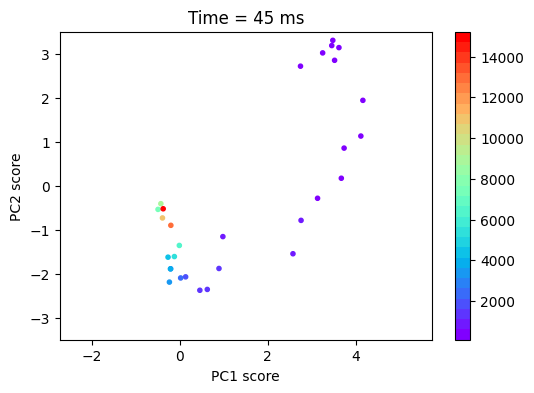Spiking Data Processing and Analysis#
ในบทเรียนนี้เราจะมาดูกันว่า จาก raw data หน้าตายุ่งๆ จะนำไปสู่ raster plot, tuning curve และ data analysis ลักษณะอื่น ๆ เพื่อทำความเข้าใจการทำงานของนิวรอนได้อย่างไร
บทเรียนนี้อ้างอิงจากเนื้อหา Brain Building Blocks session 3-4 หัวข้อ Single Neuron Studies และ From firings to meanings
Pre-processing#
Pre-processing ข้อมูลดิบ (raw data) ที่ได้จากการวัดสัญญาณประสาทด้วยขั้วไฟฟ้า (electrode) จะมีลักษณะเป็น time-series data ที่ประกอบไปด้วย action potentials หรือ spikes ที่มีลักษณะเป็นเข็มแหลมๆ (high-frequency component) อยู่บนคลื่นเตี้ยๆ (low-frequency component) ดังภาพประกอบแถวที่ 2
Filtering ซึ่งหากนำ raw data มาผ่าน low-pass filter จะได้ Local Field Potential (ภาพประกอบแถวที่ 1; เป็น time-series data ที่สามารถนำไปวิเคราะห์ต่อได้ สามารถศึกษาเพิ่มเติมได้ที่ https://www.youtube.com/watch?v=PwkYgrTE2fU)
และหากนำ raw data เดียวกันมาผ่าน high-pass filter จะได้ Multi-unit activities (spikes บนพื้นเรียบกริบ ดังภาพประกอบแถวล่างสุด)
Spike Detection/Thresholding จากนั้นจะเห็นได้ว่า เราสามารถตั้ง threshold บน Multi-unit activities เพื่อ detect spikes ได้ง่ายขึ้น (ลองจินตนาการดูว่าหากไม่ filter ก่อนแล้วตั้ง threshold เลย spike detection จะเป็นอย่างไร)
Spike Sorting/Clustering เนื่องจากสัญญาณที่ electrode บันทึกได้ มักเป็นสัญญาณที่มาจากหลายนิวรอนรอบๆ electrode นั้น (เห็นได้จาก waveforms ที่มีลักษณะต่างกันดังแสดงด้วย 4 สีที่แตกต่างกัน ดังภาพประกอบแถวที่ 3) ในกรณีที่นักวิจัยต้องการสัญญาณจากเซลล์เดี่ยว (single-unit) ขั้นตอน Spike sorting ด้วยการแยกตาม features ต่างๆ ของ waveforms จะช่วยให้สามารถแยกสัญญาณจากแต่ละเซลล์ สำหรับการวิเคราะห์พฤติกรรมของนิวรอนแบบเดี่ยวๆ ต่อไป เช่น tuning curve, tuning progression plot, etc.
ในหลายกรณี นักวิจัยสามารถ decode สัญญาณประสาทจากหลายเซลล์ (multi-unit) ซึ่งไม่จำเป็นต้องแยกสัญญาณเซลล์เดี่ยว ทำให้สามารถข้ามขั้นตอน spike sorting ไปได้
เนื่องจากโดยทั่วไป pre-processing ต้องใช้เวลามากโดยเฉพาะอย่างยิ่ง ในส่วนของ spike-sorting นอกจากนี้ raw data เป็นไฟล์ข้อมูลขนาดใหญ่เพราะใช้ sampling frequency ในการบันทึกข้อมูลค่อนข้างสูง นักวิจัยส่วนใหญ่มักจะแชร์ pre-processed data ในรูปแบบของ spike timestamps หรือ spike trains (ตำแหน่งของสามเหลี่ยมเล็กๆ บนภาพแถวล่างสุด) พร้อมกับข้อมูลของ events และ conditions ต่างๆ ในการทดลองนั้นๆ
ดังนั้น ในบทเรียนนี้เราจะเริ่มจากการใช้ข้อมูลในรูปแบบ spike timestamps
ที่มา: https://www.sciencedirect.com/science/article/pii/S0361923015000684?via%3Dihub
Set Up#
Download ข้อมูลทั้งหมด#
single_unit_spikes.csvเป็นไฟล์ที่เก็บ spike timestamps สำหรับสร้าง raster plot เพื่อ visualize ข้อมูล และสร้าง tuning curvesingle_unit_spikes_density.csvเป็นไฟล์ที่เก็บ spike density function ที่ผ่านการนำ spiking data มา convolve กับ gausian function ให้เป็น firing rate สำหรับ visualize data ในแกนเวลาmulti_unit_spiking_density.csvเป็นไฟล์ multi-unit data
!git clone https://github.com/braincodecamp/modality-exploration-spiking-data.git
!mv modality-exploration-spiking-data/* .
!rm -r modality-exploration-spiking-data
Cloning into 'modality-exploration-spiking-data'...
remote: Enumerating objects: 10, done.
remote: Total 10 (delta 0), reused 0 (delta 0), pack-reused 10 (from 1)
Receiving objects: 100% (10/10), 148.91 MiB | 17.67 MiB/s, done.
Updating files: 100% (7/7), done.
Import modules#
import os
import re
import numpy as np
import pandas as pd
import matplotlib
import matplotlib.pyplot as plt
import scipy
from sklearn.decomposition import PCA
import ipywidgets as widgets # ใช้สำหรับการทำ interactive display
Single-Unit Analyses#
ข้อมูลของ spiking data มักมาในรูปแบบของ timestamps คือเวลาที่เกิด spikes ขึ้น ในแต่ละ trials ซึ่งก่อนที่จะมีการแยกเป็น trials จะต้องมีการทำ data alignment ก่อน หากผู้เรียนจินตนาการว่าการบันทึกข้อมูลประกอบไปด้วย events ต่าง ๆ ที่เกิดขึ้นในระหว่างการทดลอง เช่น มี stimulus ขึ้นบนจอ ผู้ร่วมการทดลองกดปุ่ม หรือแตะบนจอ เป็นต้น ส่วนสัญญาณจากเซลล์ประสาท มักจะเป็นสัญญาณที่ผู้วิจัยบันทึกอย่างต่อเนื่องในระหว่างการทดลองทั้งหมด สัญญาณจากเซลล์ประสาทในแต่ละรอบการทดลอง (trials) ที่จะทำมาวิเคราะห์ จึงต้องทำมา align กับ events ต่าง ๆ ในการทดลอง เช่น stimulus alignment หรือ response alignment ก่อนที่จะนำมาหาค่าเฉลี่ยและวิเคราะห์ข้อมูลต่อไป
ในกรณีของชุดข้อมูลตัวอย่างนี้เป็นข้อมูลจากเซลล์ประสาทจากสมองส่วนรับการได้ยิน (auditory cortex) ของลิงที่ฟังเสียง (auditory stimuli) ที่ความถี่ต่างๆ ข้อมูลสัญญาณประสาทจึงต้อง align กับจุดเริ่มต้นของเสียง (stimulus onset) และแยกจากความถี่ต่าง ๆ เพื่อเปรียบเทียบสัญญาณประสาทในขณะที่กลุ่มเซลล์ประสาทนี้รับเสียงที่คลื่นความถี่ต่าง ๆ
singleUnit_spikeTimestamps = pd.read_csv('data/single_unit_spikes.csv')
print(singleUnit_spikeTimestamps.head())
unit_name analysisEpoch spikeTimes_1 spikeTimes_2 \
0 MrCassius-190328_D2_AC_R2_u021 stimOn NaN NaN
1 MrCassius-190328_D2_AC_R2_u021 stimOn NaN NaN
2 MrCassius-190328_D2_AC_R2_u021 stimOn NaN NaN
3 MrCassius-190328_D2_AC_R2_u021 stimOn NaN NaN
4 MrCassius-190328_D2_AC_R2_u021 stimOn NaN NaN
spikeTimes_3 spikeTimes_4 spikeTimes_5 nSpikes firingRate trial_index \
0 NaN NaN NaN 0 0.0 1
1 NaN NaN NaN 0 0.0 2
2 NaN NaN NaN 0 0.0 3
3 NaN NaN NaN 0 0.0 4
4 NaN NaN NaN 0 0.0 5
stmFreq stmFreqIndx timewin_s
0 800.000000 13 0.127
1 237.841423 6 0.127
2 951.365692 14 0.127
3 141.421356 3 0.127
4 168.179283 4 0.127
Raster plot#
เมื่อได้ spike timestamps มาแล้ว สิ่งที่แรกที่เรามักจะต้องทำคือ Raster plot ซึ่งเป็นกราฟที่โชว์ตำแหน่งของ spiking data ตามเวลา (spike timestamps ในแต่ละ trial จะมีค่าติดลบหากเกิดขึ้นก่อน stimulus, มีค่าเป็นศูนย์ หากเกิดขึ้นพร้อม stimulus และมีค่าเป็นบวก หากเกิดขึ้นหลัง stimulus) Raster plot จะทำให้เป็นภาพรวมของการเกิด spikes ว่ามี pattern ที่แตกต่างกันระหว่าง conditions ต่าง ๆ ของการทดลองหรือไม่
*หากการบันทึกข้อมูลเกิดขึ้นเป็นเวลานาน (เช่น หลายชั่วโมง) สามารถใช้เช็คความต่อเนื่องของการเก็บข้อมูลได้ เช่น หากสัญญาณของเซลล์ประสาทหายไปในครึ่งหลังของการเก็บข้อมูล (เซลล์อาจจะเคลื่อนออกไปไกลจาก electrode ในระหว่างการบันทึกข้อมูล) ควรตัดข้อมูลในช่วงที่ไม่มีสัญญาณออก
import matplotlib.patches as patches
# Sort trials by stmFreq
sorted_df = singleUnit_spikeTimestamps.sort_values('stmFreq')
# Create a figure and axes
fig, ax = plt.subplots()
# Extract unique stmFreq values
unique_freqs = sorted_df['stmFreq'].unique()
# Find the number of spikeTimes columns
spike_cols = [col for col in sorted_df.columns if col.startswith('spikeTimes_')]
num_spike_cols = len(spike_cols)
# Plot raster (all in blue)
for i, trial in enumerate(sorted_df.index):
for n in range(1, num_spike_cols + 1):
col = f'spikeTimes_{n}'
spike_times = sorted_df.loc[trial, col]
if not pd.isna(spike_times):
if isinstance(spike_times, (list, tuple, np.ndarray)):
ax.plot(spike_times, [i] * len(spike_times), '|', markersize=10, color='black') # Mark in black
else:
ax.plot(spike_times, i, '|', markersize=10, color='black') # Mark in black
# Add grey box for 0-200 ms
rect = patches.Rectangle((0, -0.5), 200, len(sorted_df) + 0.5, linewidth=1, edgecolor='none', facecolor='lightgrey')
ax.add_patch(rect)
# Create a mapping from y-tick values to rounded stmFreq values
y_tick_mapping = {i * 10: round(freq, 0)
for i, freq in enumerate(unique_freqs)}
# Set y-ticks and labels (every 50)
y_ticks = range(0, 301, 40)
y_tick_labels = [y_tick_mapping.get(y, '') for y in y_ticks]
ax.set_yticks(y_ticks)
ax.set_yticklabels(y_tick_labels)
# Set x-axis limits
ax.set_xlim(-100, 400)
# Set labels
ax.set_xlabel('Time')
ax.set_ylabel('Trial (sorted by stmFreq)')
ax.set_title('Raster Plot')
# Display the plot
plt.show()

Tuning curve#
หากต้องการเปรียบเทียบสัญญาณประสาทระหว่าง condition ต่าง ๆ มักทำด้วยการสร้าง tuning curve คือการนำค่าเฉลี่ยของ firing rate (Hz; จำนวน spikes ต่อ วินาที) ของเซลล์ประสาทใน condition ต่าง ๆ มา plot กราฟ ดังภาพจะเห็นได้ว่าเซลล์ประสาทเซลล์นี้มีความจำเพาะ (sensitivity) ต่อเสียงที่ความถี่ที่ 476 Hz
# Calculate mean firing rates for each stmFreq
mean_firing_rates = singleUnit_spikeTimestamps.groupby('stmFreqIndx')['firingRate'].mean()
# Sort by stmFreq
mean_firing_rates = mean_firing_rates.sort_index()
# Extract unique stmFreq values
unique_labels = singleUnit_spikeTimestamps.stmFreq.unique()
rounded_labels = [round(freq) for freq in unique_labels] # Round unique labels
rounded_labels.sort() # Sort rounded labels
# Create a figure and axes
fig, ax = plt.subplots()
# Plot tuning curve
ax.plot(mean_firing_rates.index, mean_firing_rates.values, color='teal') # Use a teal color
# Set x-tick labels using rounded stmFreq values and equally spaced locations
ax.set_xticks(range(len(unique_labels)))
ax.set_xticklabels(rounded_labels, rotation=90, ha='right') # Rotate labels 90 degrees
# Set labels
ax.set_xlabel('stmFreq')
ax.set_ylabel('Mean Firing Rate')
ax.set_title('Tuning Curve')
# Display the plot
plt.show()

Population Analyses: Multi-Unit Data#
จากนั้นหากเราต้องการเห็นภาพรวมของการตอบสนองของเซลล์ประสาทในส่วนการได้ยิน (auditory neurons) ต่อเสียงที่คลื่นความถี่ต่าง ๆ เราอาจใช้เทคนิค Principal Component Analysis (PCA) เพื่อลดมิติข้อมูลได้ ดังต่อไปนี้
Load data#
# Load and combine multi-unit spiking data files into a single dataframe
pattern = re.compile(r"multi_unit_spiking_density_part.*")
multi_unit_file_name_list = []
for curr_file in os.listdir('data'):
if pattern.match(curr_file):
multi_unit_file_name_list.append(curr_file)
multi_unit_file_name_list = np.sort(multi_unit_file_name_list)
for idx, curr_file in enumerate(multi_unit_file_name_list):
curr_df = pd.read_csv(os.path.join('data', curr_file))
if idx == 0:
multi_unit_data_df = curr_df
else:
multi_unit_data_df = pd.concat((multi_unit_data_df, curr_df), axis=0)
# Print out some information about our data
print(f"The shape of the dataframe = {multi_unit_data_df.shape}")
print(f"Column names: {multi_unit_data_df.columns}")
# Display 10 random rows of the data
multi_unit_data_df.sample(10)
The shape of the dataframe = (38040, 1005)
Column names: Index(['Unnamed: 0', 'dataset_name', 'stmFreq', 'mean_spikeDensity_1',
'mean_spikeDensity_2', 'mean_spikeDensity_3', 'mean_spikeDensity_4',
'mean_spikeDensity_5', 'mean_spikeDensity_6', 'mean_spikeDensity_7',
...
'timeBin_492', 'timeBin_493', 'timeBin_494', 'timeBin_495',
'timeBin_496', 'timeBin_497', 'timeBin_498', 'timeBin_499',
'timeBin_500', 'timeBin_501'],
dtype='object', length=1005)
| Unnamed: 0 | dataset_name | stmFreq | mean_spikeDensity_1 | mean_spikeDensity_2 | mean_spikeDensity_3 | mean_spikeDensity_4 | mean_spikeDensity_5 | mean_spikeDensity_6 | mean_spikeDensity_7 | ... | timeBin_492 | timeBin_493 | timeBin_494 | timeBin_495 | timeBin_496 | timeBin_497 | timeBin_498 | timeBin_499 | timeBin_500 | timeBin_501 | |
|---|---|---|---|---|---|---|---|---|---|---|---|---|---|---|---|---|---|---|---|---|---|
| 1517 | 1517 | MrC_190328_153519_PT_D2_AC_ch06_mu | 1902.731384 | 51.941137 | 51.196987 | 50.450069 | 49.702489 | 48.957693 | 48.216141 | 47.482921 | ... | 391 | 392 | 393 | 394 | 395 | 396 | 397 | 398 | 399 | 400 |
| 3764 | 22784 | MrC_190924_151318_PT_D4_AC_ch01_mu | 1131.370850 | 7.218200 | 7.283607 | 7.363150 | 7.456370 | 7.562724 | 7.681594 | 7.812296 | ... | 391 | 392 | 393 | 394 | 395 | 396 | 397 | 398 | 399 | 400 |
| 5602 | 15112 | MrC_190705_181401_PT_D3_AC_ch07_mu | 4525.483400 | 122.761540 | 122.570936 | 122.420210 | 122.309225 | 122.237700 | 122.204576 | 122.208384 | ... | 391 | 392 | 393 | 394 | 395 | 396 | 397 | 398 | 399 | 400 |
| 6912 | 25932 | MrM_190417_140301_PT_D2_AC_ch09_mu | 800.000000 | 3.076226 | 3.043898 | 3.019524 | 3.002515 | 2.992265 | 2.988161 | 2.989588 | ... | 391 | 392 | 393 | 394 | 395 | 396 | 397 | 398 | 399 | 400 |
| 4948 | 23968 | MrM_190415_131533_PT_D2_AC_ch24_mu | 12800.000000 | 0.387133 | 0.401584 | 0.420555 | 0.444810 | 0.473259 | 0.506550 | 0.544788 | ... | 391 | 392 | 393 | 394 | 395 | 396 | 397 | 398 | 399 | 400 |
| 1728 | 11238 | MrC_190526_141031_PT_D3_AC_ch03_mu | 2262.741700 | 19.386261 | 19.670551 | 19.947185 | 20.215207 | 20.473668 | 20.721621 | 20.958139 | ... | 391 | 392 | 393 | 394 | 395 | 396 | 397 | 398 | 399 | 400 |
| 2789 | 2789 | MrC_190330_162647_PT_D2_AC_ch05_mu | 15221.851072 | 42.319776 | 42.566868 | 42.799969 | 43.017603 | 43.221390 | 43.408696 | 43.581059 | ... | 391 | 392 | 393 | 394 | 395 | 396 | 397 | 398 | 399 | 400 |
| 3406 | 31936 | MrM_190530_210459_PT_D3_AC_ch13_mu | 1600.000000 | 7.110674 | 7.244230 | 7.375881 | 7.504853 | 7.630418 | 7.752577 | 7.869532 | ... | 391 | 392 | 393 | 394 | 395 | 396 | 397 | 398 | 399 | 400 |
| 7937 | 36467 | MrM_190823_151625_PT_D3_AC_ch10_mu | 1902.731384 | 14.798203 | 15.046170 | 15.290481 | 15.529704 | 15.762343 | 15.986841 | 16.202275 | ... | 391 | 392 | 393 | 394 | 395 | 396 | 397 | 398 | 399 | 400 |
| 2035 | 11545 | MrC_190531_133718_PT_D3_AC_ch23_mu | 7610.925536 | 5.931582 | 5.798012 | 5.662630 | 5.525437 | 5.386457 | 5.245738 | 5.103474 | ... | 391 | 392 | 393 | 394 | 395 | 396 | 397 | 398 | 399 | 400 |
10 rows × 1005 columns
Extract information from the dataframe
# Create a list of column names that can be used to extract 'timeBin' from the dataframe
time_bin_col_list = []
# Create a list of column names that can be used to extract 'mean_spike_density_col_list' from the dataframe
mean_spike_density_col_list = []
for col_name in multi_unit_data_df.columns:
if col_name.startswith('timeBin_'):
time_bin_col_list.append(col_name)
if col_name.startswith('mean_spikeDensity_'):
mean_spike_density_col_list.append(col_name)
# Check the number of time bins and the number of mean spike densities
num_time_bins = len(time_bin_col_list)
num_mean_spike_density = len(mean_spike_density_col_list)
# Check if we have the same number of time bins and mean spike densities
if num_time_bins != num_mean_spike_density:
raise ValueError("num_time_bins must equal num_mean_spike_density")
print(f"There are {num_time_bins} time bins")
print(f"There are {num_mean_spike_density} mean spike density")
# Extract the list of frequencies
stim_freq_list = np.unique(multi_unit_data_df['stmFreq'])
num_stim_freqs = len(stim_freq_list)
print(f"There are {num_stim_freqs} unique stim frequencies")
# Extract the list of units
unit_list = np.unique(multi_unit_data_df['dataset_name'])
num_units = len(unit_list)
print(f"There are {num_units} different units")
There are 501 time bins
There are 501 mean spike density
There are 30 unique stim frequencies
There are 1268 different units
Apply PCA#
We will create a feature matrix
for idx, curr_stim_freq in enumerate(stim_freq_list):
# Extract data with a specific stim frequency for all time points: num_units x num_time_points
temp = multi_unit_data_df[multi_unit_data_df['stmFreq'] == curr_stim_freq][mean_spike_density_col_list]
# Transpose the matrix such that the mean spike density from each unit becomes a feature: num_time_points x num_units
curr_features = temp.transpose().values
curr_labels_stim_freq = curr_stim_freq*np.ones((curr_features.shape[0],))
curr_labels_time = np.arange(1, num_time_bins+1)
# Combine data from different stim frequencies
if idx == 0:
features = curr_features
labels_stim_freq = curr_labels_stim_freq
labels_time = curr_labels_time
else:
features = np.concatenate((features, curr_features), axis=0)
labels_stim_freq = np.concatenate((labels_stim_freq, curr_labels_stim_freq), axis=0)
labels_time = np.concatenate((labels_time, curr_labels_time), axis=0)
print(f"Our feature matrix should have {num_time_bins*num_stim_freqs} rows and {num_units} columns")
print(f"Our feature matrix actually has {features.shape[0]} rows and {features.shape[1]} columns")
# Check if we have the same number of time bins and mean spike densities
if (features.shape[0] != num_time_bins*num_stim_freqs) or (features.shape[1] != num_units):
raise ValueError("num_time_bins must equal num_mean_spike_density")
Our feature matrix should have 15030 rows and 1268 columns
Our feature matrix actually has 15030 rows and 1268 columns
Generate the data matrix by using the mean spike density from all units at a specific time point as our features
The mean spike density for a specific stimulus frequency and a specific time bin is treated as one sample with num_units features
# ลองลดมิติโดยใช้ PCA
n_components = 2
model_pca = PCA(n_components=n_components, whiten=True, random_state=777)
features_pca = model_pca.fit_transform(features)
# Print ดู variance ที่อธิบายด้วย principal components 3 ตัวแรก
print(f"% variance captured by PC1 = {model_pca.explained_variance_ratio_[0]*100: 0.2f}")
print(f"% variance captured by PC2 = {model_pca.explained_variance_ratio_[1]*100: 0.2f}")
% variance captured by PC1 = 36.89
% variance captured by PC2 = 9.99
Plot the results using
different colors for different stim frequencies
different alpha values for different time points (from totally transparent at time bin 1 to totally opaque at the last time bin
print(f"Stimulus frequency list: {stim_freq_list}")
Stimulus frequency list: [ 100. 118.9207115 141.42135624 168.17928305
200. 237.841423 282.84271247 336.3585661
400. 475.682846 565.68542495 672.7171322
800. 951.365692 1131.3708499 1345.43426441
1600. 1902.731384 2262.7416998 2690.86852881
3200. 3805.46276801 4525.48339959 5381.73705762
6400. 7610.92553602 9050.96679919 10763.47411525
12800. 15221.85107203]
เตรียม color list สำหรับ plot
def get_equally_spaced_rainbow_colors(n):
# Get the rainbow colormap
cmap = matplotlib.colormaps['rainbow']
# Generate equally spaced indices within the colormap
indices = np.linspace(0, cmap.N - 1, n, dtype=int)
# Extract colors from the colormap
color_list = [cmap(index)[:3] for index in indices]
return color_list
display_color_list = get_equally_spaced_rainbow_colors(num_stim_freqs)
freq2display_color_dict = dict(zip(stim_freq_list, display_color_list))
custom_cmap = plt.cm.colors.ListedColormap([freq2display_color_dict[freq] for freq in freq2display_color_dict])
Plot the PC scores for all stimulus frequencies and time bins#
plt.figure(figsize=(8,8))
plt.scatter(features_pca[:,0],
features_pca[:,1],
c=labels_stim_freq,
cmap=custom_cmap,
marker='.',
alpha=1-labels_time/np.max(labels_time)) # plot สีจาง ๆ สำหรับ time bin แรก แล้วไล่ให้เข้มขึ้นเรื่อย ๆ สำหรับ time bin ถัด ๆ ไป
plt.gca().set_aspect('equal', 'datalim')
plt.xlabel('PC1 score')
plt.ylabel('PC2 score')
plt.colorbar()
plt.show()

Plot the principal components over time#
time_axis = multi_unit_data_df[time_bin_col_list].iloc[0,:].values
time2time_bin_dict = dict(zip(time_axis, np.arange(1, time_axis.shape[0]+1)))
time_bin2time_dict = dict(zip(np.arange(1, time_axis.shape[0]+1), time_axis))
fig, ax = plt.subplots(1, 2, figsize=(16, 4))
for idx_stim_freq, curr_stim_freq in enumerate(stim_freq_list):
row_indices = (labels_stim_freq == curr_stim_freq)
# Display PC1 over time for a specific stim freq
ax[0].plot(time_axis,
features_pca[row_indices,0],
c=freq2display_color_dict[curr_stim_freq], label=curr_stim_freq)
ax[0].set(xlabel='Time with respect to the stimulus (ms)', ylabel='PC1')
ax[0].grid(True)
ax[1].plot(time_axis,
features_pca[row_indices,1],
c=freq2display_color_dict[curr_stim_freq], label=curr_stim_freq)
ax[1].set(xlabel='Time with respect to the stimulus (ms)', ylabel='PC2')
ax[1].grid(True)

custom_cmap
target_time_axis_ms = 45
features_pca_specific_time_bin = features_pca[labels_time == time2time_bin_dict[target_time_axis_ms]]
labels_stim_freq_specific_time_bin = labels_stim_freq[labels_time == time2time_bin_dict[target_time_axis_ms]]
plt.figure(figsize=(6,4))
plt.scatter(features_pca_specific_time_bin[:,0],
features_pca_specific_time_bin[:,1],
c=labels_stim_freq_specific_time_bin,
cmap=custom_cmap,
marker='.')
plt.gca().set_aspect('equal', 'datalim')
plt.title(f"Time = {target_time_axis_ms} ms")
plt.xlabel('PC1 score')
plt.ylabel('PC2 score')
plt.xlim((-1.2,4.2))
plt.ylim((-3.5,3.5))
plt.colorbar()
plt.show()

Invesitgate interactive plot where you can change the time axis (ms) and see the PC results#
@widgets.interact(target_time_axis_ms=widgets.IntSlider(value=45, min=time_axis[0], max=time_axis[-1]))
def plot_pc_result_specific_stim_freq(target_time_axis_ms):
features_pca_specific_time_bin = features_pca[labels_time == time2time_bin_dict[target_time_axis_ms]]
labels_stim_freq_specific_time_bin = labels_stim_freq[labels_time == time2time_bin_dict[target_time_axis_ms]]
plt.figure(figsize=(6,4))
plt.scatter(features_pca_specific_time_bin[:,0],
features_pca_specific_time_bin[:,1],
c=labels_stim_freq_specific_time_bin,
cmap=custom_cmap,
marker='.')
plt.gca().set_aspect('equal', 'datalim')
plt.title(f"Time = {target_time_axis_ms} ms")
plt.xlabel('PC1 score')
plt.ylabel('PC2 score')
plt.xlim((-1.2,4.2))
plt.ylim((-3.5,3.5))
plt.colorbar()
plt.show()
จะเห็นได้ว่า หาก plot ตาม PC1 และ PC2 สัญญาณจากเซลล์ประสาทในสมองส่วนการได้ยิน กระจายตัวสูงสุด (ซึ่งจะทำให้สามารถ decode ได้) ที่เวลาประมาณ 45 ms หลังจาก auditory stimulus onset
*ข้อมูลนี้เป็นสัญญาณจากเซลล์ประสาทโดยรวมใน auditory cortex ซึ่งหากแยกตามบริเวณย่อย เช่น core และ belt regions อาจได้ pattern และ latency ที่ต่างกัน ซึ่งสามารถวิเคราะห์ในรายละเอียดได้ต่อไป
สำหรับผู้ที่สนใจศึกษาการวิเคราะห์ข้อมูล spiking activities แบบละเอียด (ตั้งแต่ pre-processing จนถึง analyses) สามารถศึกษาเพิ่มเติมได้ที่ https://www.youtube.com/watch?v=8xeC5CV4UB8&list=PL05umP7R6ij3SxudmSWFL_zGh0BMrRdrx&index=1
ผู้จัดทำ#
ผู้จัดทำบทเรียน ดร.ลลิตตา สุริยาอรุณโรจน์
ผู้ปรับแก้โค้ดและตรวจสอบบทเรียน ดร. อิทธิ ฉัตรนันทเวช

